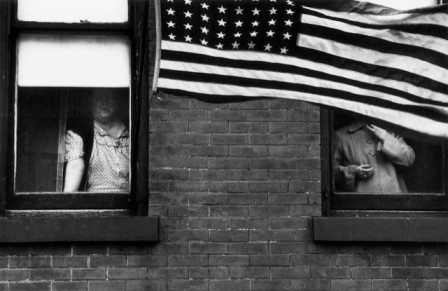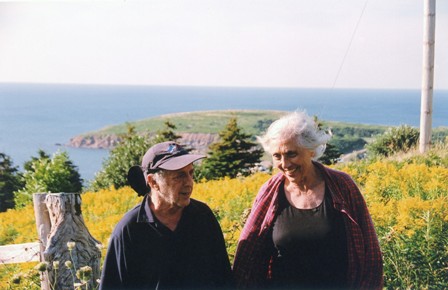Maven's Nest
Reel Life: Flick Pix

 - “Parade - Hoboken, New Jersey, 1955”, from The Americans, and Robert Frank with his wife June Leaf, 2004 in Nova Scotia, from Leaving Home, Coming Home (courtesy of Greenwich Entertainment)
- “Parade - Hoboken, New Jersey, 1955”, from The Americans, and Robert Frank with his wife June Leaf, 2004 in Nova Scotia, from Leaving Home, Coming Home (courtesy of Greenwich Entertainment)
Intimate talk with a master photographer and a revealing tour of his life
By Nora Lee Mandel
LEAVING HOME, COMING HOME: A PORTRAIT OF ROBERT FRANK
Directed and Produced by Gerald L. Fox
Released by Greenwich Entertainment
U.K. 85 min. Not Rated
Leaving Home, Coming Home is a refreshing alternative to PBS’s American Masters model so many bio-documentaries follow. Instead of the usual portentous academic talking heads and legacy-spinning loyalists, director Gerald Fox interviewed photographer/filmmaker Robert Frank while they together visited the past and present, through locales and the then 80-year-old’s extensive personal archives.
Fox originally prepared a shorter, TV version in 2004 (for the British South Bank Show) to accompany a retrospective exhibition of Frank’s work at the Tate Modern in London. But their collaboration produced so much more informative and insightful footage that the following year Fox re-edited the material into a feature, which screened at several film festivals. For whatever personal reasons, the usually very private Frank was reluctant to approve theatrical or U.S. distribution. Ironically, his agreement to an arrangement of showings at a few film festivals a year was similar to the restrictions the Rolling Stones negotiated onto his Cocksucker Blues that intimately documented their 1972 tour and has became more notorious for its absence than its content (and for a general audience overshadowed his other work). After editor Laura Israel’s impressionistic tribute to her collaborator Don’t Blink – Robert Frank world premiered at the 2015 New York Film Festival, Fox began seeking his permission for a broader release, and the nonagenarian agreed.
Two ironic themes emerge from Fox’s extended interview with Frank. First, that everything is changing around him and nothing is as good as it used to be. Second, that he’s really not important and should he really keep talking? Both actually reinforce the significance of his photographs.
Fox gets the ever-reluctant, unprepossessing Frank to find the exact locations where he took some of his favorite or well-known photographs. Starting in New York City, Fox accompanies Frank on a city bus as he extols the advantages of traveling by bus and capturing sidewalk life through the windows. From the boardwalk of Coney Island, he tries to find the building he photographed in 1958 by asking ever older denizens of the neighborhood to mine their memories. (Jazzy music helps set the original time period.) They are more impressed that someone is filming him.
Frank is least voluble about his family. His expressions communicate his negative feelings about living with his parents in Zurich during the 1930’s and 1940’s, with few images of them. But he concedes their stiff attitudes were intertwined with constant tensions over being marooned as Jews in Switzerland with the Nazi threat just across the border and over the airwaves. When he discovered a neighbor’s photography studio, the camera opened up a way to look out and gave him useful skills. As soon as post-war travel was possible in 1947, he connected with a New York cousin.
Frank chuckles at the series of coincidences that led to his free-lance jobs as a fashion photographer, but he had a pent-up wanderlust. After marriage to artist Mary Lockspeiser and the birth of their two children, they traveled with him for several years through the middle of the 1950’s, settling for awhile in Paris, all illustrated with his photographs. He continued free-lance magazine work as a necessity, but what he clearly loved was photographing everyday people in the places he visited. He was still proud of his intense series on Welsh coal miners, where he accompanied them down in the tunnels, in contrast to the impeccably dressed financiers walking to offices in the foggy City of London.
Frank returned to travel all over the U.S. for two years, frequently with his family, taking thousands of photographs in cities. (He doesn’t mention here the anti-Semitic incidents he experienced.) A selection published as The Americans made his reputation; its 50th anniversary was marked in 2009 with a major retrospective exhibition that traveled to several American museums.
The photographs of Frank’s wife and little children from those travels lead to the most emotional discussions, as he gradually reveals his son’s and daughter’s tragic deaths when young adults, which also led to the break-up of his marriage. But when the interview moves from the city to his retreat in rural Nova Scotia, we meet the life force who keeps him going, his second wife, artist June Leaf. He beams about her consistent work ethic and creative pieces, while their constant kibbitzing is the charming interaction of a long and loving relationship. As much as Frank complains first how dirty his Greenwich Village neighborhood was when he left, then its gentrification bothers him now, the changing of the seasons up north calms and stabilizes him, as he explores making collages, especially in tribute to his children.
Fox carefully intersperses into their conversations full-screen views of Frank’s photographs, with their dates, that allows the audience to appreciate his artistry, even as Frank modestly insists on his casual technique. There also clips from the films Frank made from 1959 on. He gets the most enthused about his first film, Pull My Daisy, and how Jack Kerouac came to narrate the scenes of the Beats hanging out.
The parallels in his trajectory and subjects to that documented in Sasha Waters Freyer’s Garry Winogrand: All Things Are Photographable (2018) are striking. But Frank is a nicer guy to listen to and watch, and his photographs are more empathetic. Evidently Fox made a point of using film stock and cinematographic techniques similar to Frank’s, but those subtleties went by me. Though Fox has said elsewhere that he felt their shared Jewishness created a bond, he doesn’t ask Frank more about his family, nor about his fellow photographers. Maybe Frank didn’t want to talk more about them.
Update: Robert Frank died in his beloved Cape Breton just three months after this U.S. theatrical premiere at New York’s Film Forum. We are fortunate to have heard so much about his life and work that can bring his art to new eyes. Now streaming on iTunes, Amazon Video, and Google Play.
Originally posted 5/29/2019
Nora Lee Mandel is a member of New York Film Critics Online and the Alliance of Women Film Journalists. Her reviews are counted in the Rotten Tomatoes TomatoMeter:
 Complete Index to Nora Lee Mandel's Movie Reviews
Complete Index to Nora Lee Mandel's Movie Reviews
Since August 2006, edited versions of most of my reviews of documentaries/indie/foreign films are at Film-Forward; since 2012, festival overviews at FilmFestivalTraveler; and, since 2016, coverage of women-made films at FF2 Media. Shorter versions of my older reviews are at IMDb's comments, where non-English-language films are listed by their native titles.
To the Mandel Maven's Nest Reel Life: Flick Pix
Copyright © 2020


 - “Parade - Hoboken, New Jersey, 1955”, from The Americans, and Robert Frank with his wife June Leaf, 2004 in Nova Scotia, from Leaving Home, Coming Home (courtesy of Greenwich Entertainment)
- “Parade - Hoboken, New Jersey, 1955”, from The Americans, and Robert Frank with his wife June Leaf, 2004 in Nova Scotia, from Leaving Home, Coming Home (courtesy of Greenwich Entertainment)